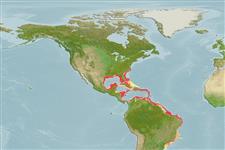Common names from other countries
Environment: milieu / climate zone / depth range / distribution range
Οικολογία
; εύρος βάθους 1 - 151 m (Ref. 101602). Tropical; 35°N - 29°S, 98°W - 34°W
Western Atlantic and Western Central Pacific: From North Carolina and Bermuda, to Santa Catarina State, Brazil; Philippines.
Length at first maturity / Μέγεθος / Βάρος / Age
Maturity: Lm ? range ? - ? cm Max length : 9.0 cm SHL αρσενικό/απροσδιόριστο; (Ref. 83435); common length : 11.0 cm SHL αρσενικό/απροσδιόριστο; (Ref. 344)
Shell circular, inequivalve, lower valve strongly concave, upper valve flatter, slightly convex. Hinge with wing-like projections of equal size. Sculpture on upper (flat) valve of about 35 ribs and interspaces of about same width. Lower (deep) valve with about 20 less prominent ribs. Colour: tan to light brown. Inner surface of lower valve white. Upper valve mottled with reddish brown and dark brown markings.
Subtidal species, partly buried in sand (Ref. 344) wherein they filter the interface between the seabed and the water column for food, mainly diatoms (Ref. 104076). Capable of limited rotational movement which allows resuspension of sediments, thus increasing food availability in its surroundings (Ref. 104076). Individuals form aggregations (Ref. 344). Also Refs. 8319, 112947.
Life cycle and mating behavior
Γεννητική Ωρίμανση | Αναπαραγωγή | Γεννοβολία | Αβγά | Γονιμότητα | Προνύμφες
Members of the class Bivalvia are mostly gonochoric, some are protandric hermaphrodites (Ref. 833). Species is a hermaphrodite exhibiting asynchronous reproduction. Spawning occurs during summer, autumn and spring. Protandric individuals dominate during spring time while proterogynous individuals dominate in summer and autumn (Ref. 93548). Life cycle: Embryos develop into free-swimming trocophore larvae, succeeded by the bivalve veliger, resembling a miniature clam (Ref. 833).
Leal, J.H. 2003. (Ref. 344)
IUCN Red List Status (Ref. 130435)
CITES status (Ref. 108899)
Not Evaluated
Not Evaluated
Human uses
αλιεία: Εμπορικό(ά)
| FishSource |
Εργαλεία
Διαδικτυακές πηγές
Estimates based on models
Preferred temperature
(Ref.
115969): 22.9 - 28, mean 26.5 (based on 370 cells).
